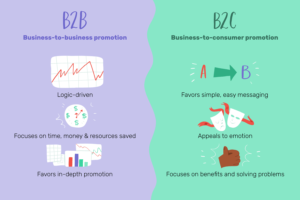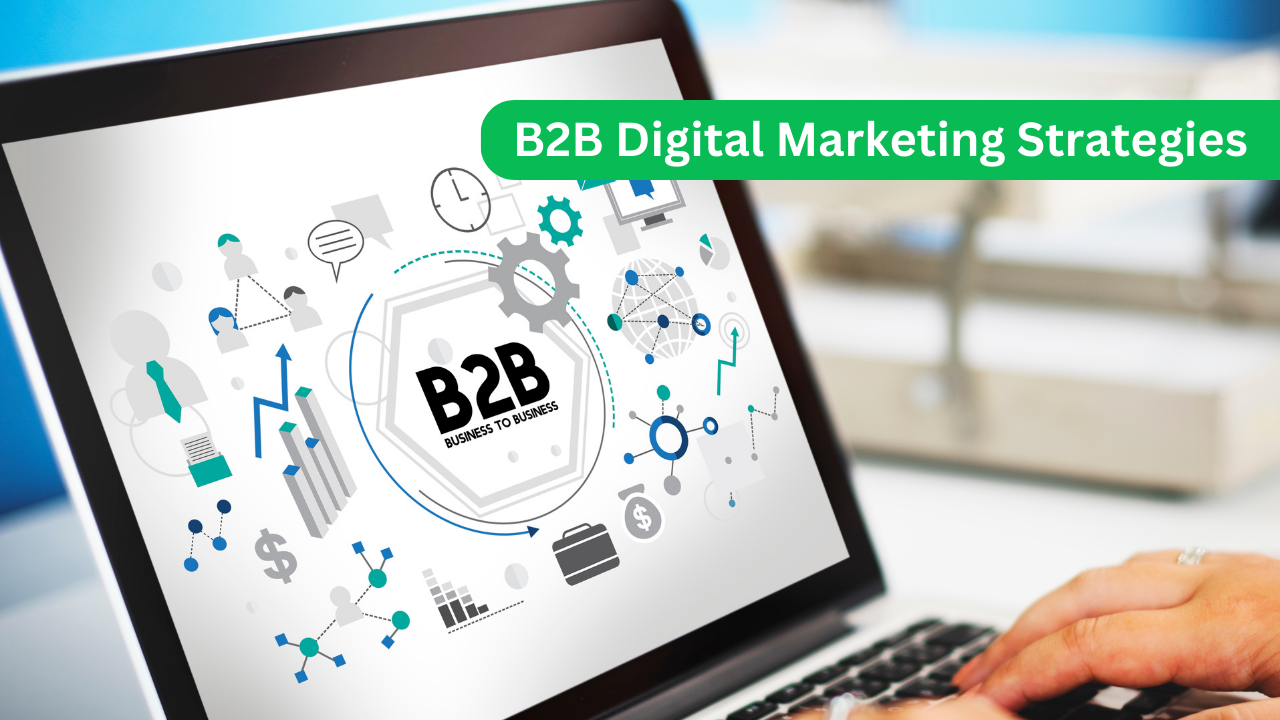As the business world becomes increasingly digitized, B2B marketers are faced with a unique set of challenges. Unlike B2C marketing, which is focused on capturing the attention of individual consumers, B2B marketing is all about selling products and services to other businesses.
But with the right digital marketing strategies in place, B2B marketers can unlock the full potential of the online marketplace and take their businesses to new heights. In this article, I’ll explore the key components of a successful B2B digital marketing strategies, best practices for B2B email and social media marketing, how to choose the right lead generation company, and more.
Understanding the B2B Sales Process
Before we dive into the specifics of B2B digital marketing, it’s important to understand the unique characteristics of the B2B sales process. Unlike B2C sales, which are often impulse-driven and emotional, B2B sales are typically based on rational decision-making and long-term relationships. The B2B sales cycle can be lengthy and complex, involving multiple decision-makers and stakeholders, and often involves large sums of money. As a result, B2B marketers need to take a more targeted and personalized approach to their marketing efforts in order to build trust and credibility with potential customers.
Related Topic: Maximizing Your Performance Marketing Strategies for Achieving 10X Success
Key Components of a Successful B2B Digital Marketing Strategies
A successful B2B digital marketing strategy is built on a foundation of clear goals, a deep understanding of your target audience, and a comprehensive plan for reaching and engaging with them. Here are the key components of a successful B2B digital marketing strategy:
1. Establish Clear Goals
Before you begin any marketing campaign, it’s important to establish clear and measurable goals. This will help you stay focused on what you want to achieve and ensure that you can track progress and measure ROI. Common B2B marketing goals include generating leads, increasing brand awareness, driving website traffic, and boosting sales.
2. Identify Your Target Audience
In order to effectively reach and engage your target audience, you need to have a deep understanding of who they are and what motivates them. This means conducting market research, analyzing customer data, and creating buyer personas to guide your marketing efforts.
3. Develop a Comprehensive Marketing Plan
A comprehensive B2B marketing plan should include a mix of tactics that are tailored to your target audience and goals. This may include email marketing, social media marketing, content marketing, SEO, PPC advertising, and more. The key is to develop a cohesive plan that integrates all of these tactics and ensures that they are working together to achieve your goals.
B2B Email Marketing: Best Practices and Examples
Email marketing is one of the most effective tools in a B2B marketer’s arsenal, with an average ROI of $42 for every $1 spent. But in order to see success with email marketing, it’s important to follow best practices and create compelling, targeted campaigns. Here are some best practices for B2B email marketing:
1. Personalize Your Emails
Personalization is key to effective B2B email marketing. By using data to customize your emails for individual recipients, you can increase open rates, click-through rates, and conversions. Personalization can include everything from using the recipient’s name in the subject line to tailoring the content of the email to their specific interests and needs.
2. Segment Your Email List
Segmentation is the process of dividing your email list into smaller groups based on specific criteria, such as industry, job title, or past purchase behavior. By segmenting your list, you can deliver more targeted and relevant content to each group, which can lead to higher engagement and conversions.
3. Use Compelling Subject Lines and Calls-to-Action
Your subject line and call-to-action (CTA) are two of the most important elements of your email. Your subject line should be attention-grabbing and relevant to the content of the email, while your CTA should be clear and compelling, encouraging the recipient to take action.
Leveraging Social Media for B2B Marketing
While social media may not be the first thing that comes to mind when you think of B2B marketing, it can be a powerful tool for building brand awareness, engaging with customers, and driving traffic to your website. Here are some best practices for B2B social media marketing:
1. Choose the Right Platforms
There are a lot of social media platforms out there, so it’s important to choose the ones that are most relevant to your target audience. LinkedIn is a popular platform for B2B marketers, as it is focused on professional networking and has a large user base of business professionals.
2. Share Relevant and Engaging Content
In order to build a following on social media, you need to share content that is both relevant and engaging to your target audience. This can include blog posts, infographics, videos, and more.
3. Engage with Your Followers
Social media is a two-way conversation, so it’s important to engage with your followers by responding to comments and messages, sharing user-generated content, and participating in relevant industry conversations.
B2B vs B2C Marketing: What’s the Difference?

While there are some similarities between B2B and B2C marketing, there are also some key differences that require a different approach. Here are some of the main differences between B2B and B2C marketing:
1. Decision-Making Process
B2B sales typically involve a longer and more complex decision-making process than B2C sales, which means that B2B marketing needs to focus on building trust and credibility with potential customers.
2. Target Audience
B2B marketing is focused on selling products and services to other businesses, which means that the target audience is often more niche and specialized than in B2C marketing.
3. Relationship Building
Because B2B sales often involve long-term contracts and relationships, B2B marketers need to focus on building strong, lasting relationships with customers.
Lead Generation Companies: How to Choose the Right One for Your Business
Lead generation is a critical component of B2B marketing, as it is the process of identifying and nurturing potential customers until they are ready to make a purchase. While you can generate leads in-house, many B2B companies choose to work with lead generation companies to outsource this process. Here are some tips for choosing the right lead generation company for your business:
1. Look for Industry Experience
Ideally, you want to work with a lead generation company that has experience in your industry, as they will have a better understanding of your target audience and how to reach them.
2. Evaluate Their Processes and Technology
Before you choose a lead generation company, be sure to understand its processes and technology. Do they use advanced data analytics and lead-scoring algorithms to identify the most promising leads? Are they using the latest marketing automation tools to nurture leads and track progress?
3. Review Their Track Record
Finally, be sure to review the lead generation company’s track record before you sign on. Have they worked with other companies in your industry? What kind of results have they achieved? Are they transparent about their methods and ROI?
Measuring ROI for B2B Digital Marketing Campaigns
One of the biggest challenges of B2B digital marketing is measuring ROI. Unlike traditional marketing channels, digital marketing can be more difficult to track and measure, which makes it challenging to prove the value of your campaigns. Here are some tips for measuring ROI for B2B digital marketing campaigns:
1. Define Your Metrics
Before you begin any campaign, it’s important to define the metrics that you will use to measure success. These may include website traffic, lead generation, conversion rates, and more.
2. Use Analytics Tools
There are a variety of analytics tools available that can help you track the performance of your digital marketing campaigns, including Google Analytics, HubSpot, and Marketo.
3. Continuously Monitor and Optimize
Measuring ROI is an ongoing process, and it’s important to continuously monitor and optimize your campaigns in order to improve results over time.
Common Mistakes to Avoid in B2B Digital Marketing
While B2B digital marketing can be incredibly effective when done right, there are also some common mistakes that can sabotage your efforts. Here are some mistakes to avoid in B2B digital marketing:
1. Focusing Too Much on Features, Not Benefits
In order to sell to other businesses, you need to be able to clearly communicate the benefits of your products or services. Many B2B marketers make the mistake of focusing too much on features, which can be confusing and overwhelming to potential customers.
2. Neglecting Mobile Optimization
More and more B2B buyers are using their mobile devices to research and purchase products and services. If your website and marketing materials are not optimized for mobile, you could be missing out on valuable opportunities.
3. Not Using Data to Drive Decisions
In order to be successful in B2B digital marketing, you need to be data-driven. This means using data to make informed decisions about your marketing strategy, rather than relying on guesswork or assumptions.
Future Trends in B2B Digital Marketing
As the digital landscape continues to evolve, there are several trends that are shaping the future of B2B digital marketing. Here are a few trends to keep an eye on:
1. AI and Machine Learning
Artificial intelligence and machine learning are already playing a role in B2B marketing, and this trend is only going to continue. AI-powered tools can help with everything from lead scoring and segmentation to content creation and personalization.
2. Interactive Content
Interactive content, such as quizzes, calculators, and assessments, is becoming increasingly popular in B2B marketing. This type of content can be highly engaging and can help to generate leads and build brand awareness.
3. Virtual and Augmented Reality
Virtual and augmented reality are still in the early stages of adoption in B2B marketing, but they have the potential to revolutionize the way that businesses showcase their products and services. These technologies can provide immersive, interactive experiences that can help to drive engagement and sales.
Conclusion: Taking the First Step Towards a Game-Changing B2B Digital Marketing Strategy
B2B digital marketing is a complex and constantly-evolving field, but with the right strategies and tools in place, you can achieve great success. By taking the time to understand your target audience, setting clear goals, and using data to drive decisions, you can create a game-changing B2B digital marketing strategy that drives leads, sales, and growth for your business.
So take the first step today and start exploring the possibilities of B2B digital marketing!
Administrator
Digital Pranav

